All the solutions provided in McGraw Hill My Math Grade 5 Answer Key PDF Chapter 6 Lesson 4 Use Models to Multiply Decimals will give you a clear idea of the concepts.
McGraw-Hill My Math Grade 5 Answer Key Chapter 6 Lesson 4 Use Models to Multiply Decimals
Draw It
Find 0.3 × 0.7 using a decimal model.
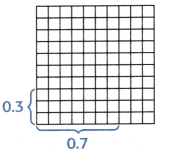
1. Use one 10-by-10 decimal model.
2. Shade a rectangle that is 0.3 unit wide and 0.7 unit long.
3. There are ___________ hundredths in the shaded region. The shaded region represents the area of a rectangle with a length of 0.7 unit and a width of 0.3 unit. So, 0.3 × 0.7 = ___________.
Answer:
0.3 × 0.7 = 0.21
Explanation:
There are 0.21 hundredths in the shaded region.
The shaded region represents the area of a rectangle,
with a length of 0.7 unit and a width of 0.3 unit.
So, 0.3 × 0.7 = 0.21
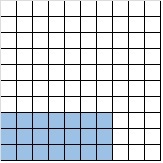
Talk About It
Question 1.
How are the equations 3 × 7 = 21 and 0.3 × 0.7 = 0.21 similar? How are they different?
Answer:
Both are same.
3 × 7 = 21 and 0.3 × 0.7 = 0.21 similar
Explanation:
3 x 7 = 21 is multiplication of whole numbers.
0.3 x 0.7=0.21 is multiplication of decimal numbers.
Question 2.
Mathematical PRACTICE Use Math Tools How is using a model to multiply 0.3 by 0.7 similar to finding the area of a rectangle?
Answer:
Mathematical decimal multiplication model and shading of area model by
Using three 10-by-10 decimal models to find the area of rectangle are similar as shown in the above questions.
Explanation:
There are 0.21 hundredths in the shaded region.
The shaded region represents the area of a rectangle,
with a length of 0.7 unit and a width of 0.3 unit.
So, 0.3 × 0.7 = 0.21

Try It
Find 0.4 × 2.4 using decimal models.
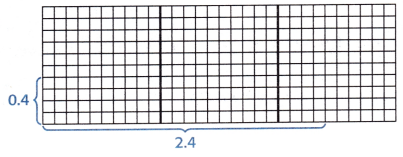
1. Use three 10-by-10 decimal models side by side.
2. Shade a rectangle that is 0.4 unit wide and ____________ units long.
3. Shade the same amount of squares on a 10-by-10 grid.
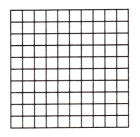
4. There are ___________ hundredths in the shaded region.
So, 0.4 × 2.4 = ____________.
Answer:
0.4 × 2.4 = 0.96
Explanation:
Shade a rectangle that is 0.4 unit wide and 2.4 units long.
Shade the same amount of squares on a 10-by-10 grid.

There are 0.96 hundredths in the shaded region.
So, 0.4 × 2.4 = 0.96
Talk About It
Question 3.
Without using models, explain why 2 tenths times 3 tenths is equal to 6 hundredths. Use place value in your explanation.
Answer:
0.2 x 0.3 = 0.06
Explanation:
Decimal place value. The first digit after the decimal represents the tenths place.
The next digit after the decimal represents the hundredths place.
0.2 x 0.3 = 0.06
Question 4.
The table shows some factors and their products. Study the table. Write a rule you can use to find the product of two decimals, both to the tenths place, without using models.

Answer:
0.3 x 0.7 = 0.21
\(\frac{3}{10}\) x \(\frac{7}{10}\) = \(\frac{21}{100}\)
Explanation:
When multiplying a number by a decimal less than one,
the product will be smaller than the number being multiplied.
This is because we are finding a fractional amount of a quantity.
0.3 x 0.7 = 0.21
Question 5.
Mathematical PRACTICE Stop and Reflect Without using models, find 0.4 × 0.8. Explain how you found the product.
Answer:
0.4 x 0.8 = 0.32
Explanation:
\(\frac{4}{10}\) x \(\frac{8}{10}\) = \(\frac{32}{100}\)
When multiplying a number by a decimal less than one,
the product will be smaller than the number being multiplied.
This is because we are finding a fractional amount of a quantity.
0.4 x 0.8 = 0.32
Practice It
Shade the decimal models to find each product.
Question 6.
0.4 × 0.8 = ___________
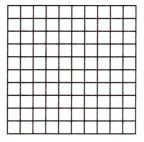
Answer:
0.32

\(\frac{4}{10}\) x \(\frac{8}{10}\) = \(\frac{32}{100}\)
Explanation:
When multiplying a number by a decimal less than one,
the product will be smaller than the number being multiplied.
This is because we are finding a fractional amount of a quantity.
0.4 x 0.8 = 0.32
Question 7.
0.5 × 0.6 = ___________

Answer:
0.3
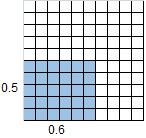
\(\frac{5}{10}\) x \(\frac{6}{10}\) = \(\frac{30}{100}\)
Explanation:
When multiplying a number by a decimal less than one,
the product will be smaller than the number being multiplied.
This is because we are finding a fractional amount of a quantity.
0.5 x 0.6 = 0.30
Question 8.
0.2 × 0.9 = _____________

Answer:
0.18
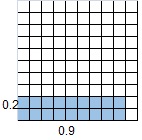
\(\frac{2}{10}\) x \(\frac{9}{10}\) = \(\frac{18}{100}\)
Explanation:
When multiplying a number by a decimal less than one,
the product will be smaller than the number being multiplied.
This is because we are finding a fractional amount of a quantity.
0.2 x 0.9 = 0.18
Question 9.
0.4 × 0.6 = ______________

Answer:
0.24
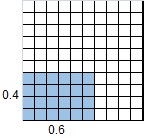
\(\frac{4}{10}\) x \(\frac{6}{10}\) = \(\frac{24}{100}\)
Explanation:
When multiplying a number by a decimal less than one,
the product will be smaller than the number being multiplied.
This is because we are finding a fractional amount of a quantity.
0.4 x 0.6 = 0.24
Question 10.
0.3 × 1.8 = _____________

Answer:
0.54
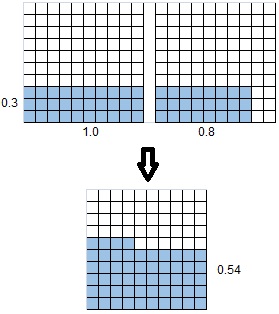
\(\frac{3}{10}\) x \(\frac{18}{10}\) = \(\frac{54}{100}\)
Explanation:
When multiplying a number by a decimal less than one,
the product will be smaller than the number being multiplied.
This is because we are finding a fractional amount of a quantity.
0.3 x 1.8 = 0.54
Question 11.
0.2 × 1.4 = ______________

Answer:
0.28
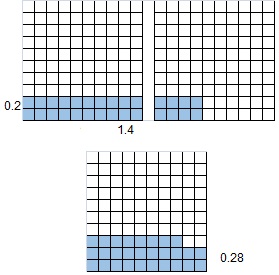
\(\frac{2}{10}\) x \(\frac{14}{10}\) = \(\frac{28}{100}\)
Explanation:
When multiplying a number by a decimal less than one,
the product will be smaller than the number being multiplied.
This is because we are finding a fractional amount of a quantity.
0.2 x 1.4 = 0.28
Apply It
Question 12.
Diana’s house has a rectangular window on the door with a height of 1.5 feet and a width of 0.8 feet. What is the area of the window? Shade the decimal models to solve the problem.
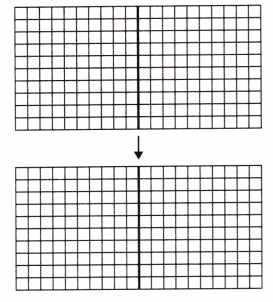
Answer:
1.2
Explanation:
0.8 x 1.5 = 1.2

\(\frac{8}{10}\) x \(\frac{15}{10}\) = \(\frac{120}{100}\)
Explanation:
When multiplying a number by a decimal less than one, t
he product will be smaller than the number being multiplied.
This is because we are finding a fractional amount of a quantity.
0.8 x 1.5 = 1.2
Question 13.
Mathematical PRACTICE Reason Use the decimal model below to explain why 0.5 × 0.11 is 0.055.
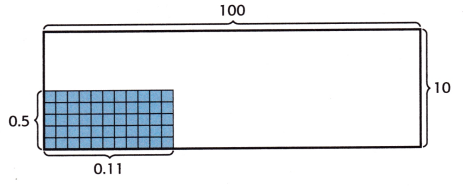
Answer:
0.5 x 0.11 = 0.055
\(\frac{5}{10}\) x \(\frac{11}{100}\) = \(\frac{55}{1000}\)
Explanation:
When multiplying a number by a decimal less than one,
the product will be smaller than the number being multiplied.
This is because we are finding a fractional amount of a quantity.
0.5 x 0.11 = 0.055
Write About It
Question 14.
How does a model help me multiply decimals?
Answer:
A model is a grid that helps in the multiplication of decimals and whole numbers.
It’s a grid with 10 columns and 10 rows.
It is very easy to solve for the missing factor or product.
McGraw Hill My Math Grade 5 Chapter 6 Lesson 4 My Homework Answer Key
Practice
Shade the decimal models to find each product.
Question 1.
0.7 × 0.5 = ____________
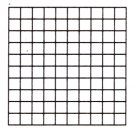
Answer:
0.35
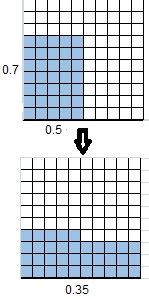
Explanation:
When multiplying a number by a decimal less than one,
the product will be smaller than the number being multiplied.
This is because we are finding a fractional amount of a quantity.
0.7 x 0.5 = 0.35
Question 2.
0.8 × 0.2 = _____________

Answer:
0.16

Explanation:
When multiplying a number by a decimal less than one,
the product will be smaller than the number being multiplied.
This is because we are finding a fractional amount of a quantity.
0.8 x 0.2 = 0.16
Question 3.
0.6 × 2.2 = _____________

Answer:
1.32
0.6 × 2.2 = 1.32

Explanation:
When multiplying a number by a decimal more than one,
the product will be larger than the number being multiplied.
This is because we are finding a fractional amount of a quantity.
0.6 x 2.2 = 1.32
Problem Solving
Shade the decimal models to solve each problem.
Question 4.
Lanny bought 1.4 pounds of rice that cost $0.40 per pound. How much does Lanny pay for the rice?

Answer:
$0.56
0.4 × 1.4 = 0.56

Explanation:
Lanny bought 1.4 pounds of rice that cost $0.40 per pound.
When multiplying a number by a decimal more than one,
the product will be larger than the number being multiplied.
This is because we are finding a fractional amount of a quantity.
Total amount paid by Lanny for rice is,
0.4 x 1.4 = $0.56
Question 5.
Abbey purchased a poster that had a height of 2 feet and a width of 0.7 foot. What is the area of Abbey’s poster?

Answer:
1.4 square feet.
0.7 × 2.0 = 1.4

Explanation:
Abbey purchased a poster that had a height of 2 feet and a width of 0.7 foot.
When multiplying a number by a decimal more than one,
the product will be larger than the number being multiplied.
This is because we are finding a fractional amount of a quantity.
The area of Abbey’s poster is,
0.7 x 2.0 = 1.4 square feet.
Question 6.
Mathematical PRACTICE Use Math Tools Diana spends 0.8 hour per day at the pool. If she goes to the pool for 2 days one week, how many total hours does Diana spend at the pool that week?

Answer:
1.6 hours.
0.8 × 2.0 = 1.6

Explanation:
Diana spends 0.8 hour per day at the pool.
If she goes to the pool for 2 days one week,
When multiplying a number by a decimal more than one,
the product will be larger than the number being multiplied.
This is because we are finding a fractional amount of a quantity.
Total hours does Diana spend at the pool that week,
0.8 x 2.0 = 1.6 hours.